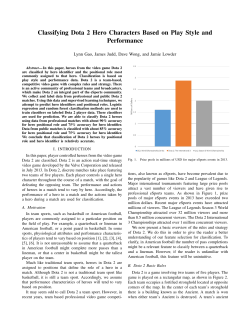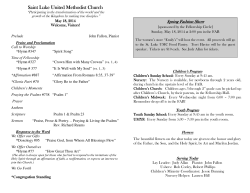
Lesson 1. The Heroic Archetype
Lesson 1. The Heroic Archetype To begin your own heroic quest, read through the following information about the heroic archetype and how Luke Skywalker fits it! Stanley Kunitz, former Poet Laureate of the United States, once said, “Old myths, old gods, old heroes have never died. They are only sleeping at the bottom of our mind, waiting for our call. We have need for them. They represent the wisdom of our race.” The idea of the hero is a theme in all media – books, music, art, even video games! American author Joseph Campbell (at right) is best known for his work with the myths of the world and how they connect us. Borrowing from James Joyce, he applied the term “monomyth” to refer to the pattern that myths around the world typically follow. His basic argument is that heroes in all cultures share a pattern that is predictable and recognizable. A pattern that is followed by all or nearly a ll things of the same kind it is called an archetype, a concept developed by psychiatrist Carl Jung (the word comes from the Greek word for “model”). Campbell outlined the steps taken by heroes in virtually all cultures in his book The Hero with a Thousand Faces. Other authors have modified Campbell’s 17-step pattern, and that’s what we’ll do as well. We’ll look at nine steps and find examples of them in movies, books and history. Keep in mind that heroes do not have to follow all of these (or Campbell’s 17) steps in order to be a hero. You can be a hero and only experience some parts of the pattern. Once you become familiar with these ideas, you will see them everywhere. So let’s march a hero through the steps… How about Luke Skywalker? He’s a good one to look at because the creator of Star Wars, George Lucas, deliberately modeled the story on classical mythology. The Heroic Archetype adapted from Joseph Campbell’s The Hero with 1,000 Faces and other sources 1. Pattern Step Unusual birth Description This can be as simple as being the son or daughter of a king. Sometimes, this will be a secret. Possibly the unusual circumstance will be very odd, perhaps even magical. The hero could be born into danger, or the birth could be a fulfillment of prophesy. Luke Son of one of the greatest Jedi knights of all time (who has gone over to the Dark Side), his true parentage is hidden from him and nearly all around him. Picture of Joseph Campbell copyright © Joseph Campbell Foundation (jcf.org); used with permission Hero-1.1 © 2010: This lesson plan is the property of the Mensa Education & Research Foundation, www.mensafoundation.org. It is provided as a complimentary service to the public . Reproduction and distribution without modification are allowed. Images, links and linked content referenced herein are the property of the originating entities. 2. Pattern Step Departure: Leaves family Description Something compels the hero to leave his or her family. Heroes may begin their heroic journeys because of a discovery of their true identities and a desire to fulfill them. Sometimes it’s because he or she has done something wrong and needs to get out of town quickly! Often, someone will bring the hero a message from afar that precipitates the departure. Occasionally the hero will try to avoid accepting the destiny of being a hero, but usually this doesn’t last. Luke The deaths of his aunt and uncle and Princess Leia’s message in R2D2 instigate Luke’s departure from his home planet of Tatooine. 3. Special weapon The hero often has a special weapon that only the hero can use. The weapon may have magical powers. Luke has his lightsaber and the Force. 4. Journey/Test The hero must go on a journey or a quest to prove him/herself a true hero. Sometimes the test is just one large task, but it can also be a series of challenges. If the hero has to cross to a “dark side” in order to go on the journey, this is called a “threshold.” Luke faces a series of challenges, including learning to be “one with the Force,” wielding his lightsaber, facing his father and destroying the Death Star. 5. Supernatural help The hero is often aided by a helper, and the helper is frequently magical or supernatural. This helper may be a mentor or a guide. Luke has Obi-Wan Kenobi and Yoda. He also has the more human Han Solo. Photo TM & © 2010 Lucasfilm Ltd. All Rights Reserved. Used under authorization. Hero-1.2 © 2010: This lesson plan is the property of the Mensa Education & Research Foundation, www.mensafoundation.org. It is provided as a complimentary service to the public . Reproduction and distribution without modification are allowed. Images, links and linked content referenced herein are the property of the originating entities. Pattern Step Unhealable wound/Descent into hell Description This wound can be physical or emotional. It is something that the hero encounters on his/her journey and from which he/she never recovers. Luke Han Solo’s going into the carbon-freezing chamber is a strong example of this; so is Luke’s losing his hand and going into the abyss rather than go to the Dark Side. 7. Return The hero (sometimes reluctantly) will return to the place he/she began. This return is often accompanied by some kind of benefit the hero is bringing back (perhaps a magic potion, weapon or salvation of some kind). Luke’s return to “normal” life is accompanied by his gift of peace for the rebel forces and destruction of the evil Empire. 8. Atonement with/for father The hero will make up with his/her father. Sometimes, the hero is making up for the misdeeds or evil done by the father. Luke Skywalker saves his father and also makes up for the evil his father had done while serving the Dark Side. 6. In this picture, notice how Luke is in white and Anakin is in dark clothing. Often in literature white is a symbol of goodness and purity. 9. Apotheosis (means “exaltation to a divine level”) As with the step above, the hero’s apotheosis is part of the Return, but it merits its own step because this is when the hero crosses over into some type of eternal reward for his/her efforts. It may be simply a period of rest, or it may be a promise or realization of eternal reward. Photos TM Luke sees the “ghosts” of Obi-Wan, Yoda and Anakin Skywalker, hinting at Luke’s future admittance into Jedi “heaven.” & © 2010 Lucasfilm Ltd. All Rights Reserved. Used under authorization. Hero-1.3 © 2010: This lesson plan is the property of the Mensa Education & Research Foundation, www.mensafoundation.org. It is provided as a complimentary service to the public . Reproduction and distribution without modification are allowed. Images, links and linked content referenced herein are the property of the originating entities.
© Copyright 2025





















